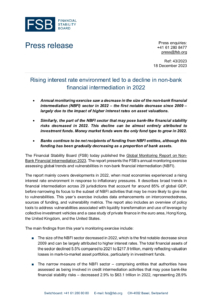This report describes broad trends in financial intermediation across 29 jurisdictions that account for around 85% of global GDP. The report mainly covers developments in 2022, when most economies experienced a rising rate environment in response to inflationary pressures.
The value of total global financial assets against the backdrop of higher interest rates in response to inflationary pressures. Amid lower asset valuations, total global financial assets decreased 0.4% in 2022, following years of continued and rapid growth. The size of the NBFI sector decreased in 2022 – the first notable decrease since 2009, which can be largely attributed to the impact of higher interest rates. Total financial assets of the NBFI sector declined 5.5% in 2022 compared to 2021, to $217.9 trillion, mainly reflecting valuation losses in mark-to-market asset portfolios, in particular in investment funds. The relative share of total global financial assets held by the NBFI sector decreased to 47.2%.
Since 2017 investment funds have driven changes in NBFI asset levels, and this continued to be the case in 2022, as investment funds led the decline in NBFI assets. The decrease in the assets of other investment funds (OIFs) – defined as funds other than money market funds (MMFs), hedge funds and real estate investment trusts and funds – accounted for approximately two-thirds of the overall decline in NBFI sector assets in 2022. Insurance corporations and pension funds collectively accounted for almost all of the rest of the decline. MMFs experienced different trends to other types of funds: inflows over 2022 increased their assets under management.
Banks continued to be net recipients of funding from the NBFI sector, although this funding has been decreasing since 2013. In contrast, some NBFI entities’ use of funding from banks has increased. Enhancements in this year’s report reduced unspecified linkages across all non-bank entity types and were most notable in the case of pension funds, where identified linkages increased 25 – 30 percentage points with regard to both claims and liabilities.
The narrow measure of the NBFI sector decreased 2.9% to $63.1 trillion in 2022, representing 28.9% of total NBFI assets and 13.9% of total global financial assets. The narrow measure reflects an activity-based “economic function” (EF) assessment of risks.
To complement the monitoring of vulnerabilities, jurisdictions also provided information on the availability of policy tools for collective investment vehicles (detailed in Box 2-1 of the report).
The report also includes a case study exploring the role of NBFI in private finance and providing examples in key selected jurisdictions.
Market prices have generally rebounded since the analysis presented in this report. The assets under management of both short-term government and non-government MMFs increased due to inflows, especially following the banking sector turmoil in March 2023. These developments and potential implications for vulnerabilities in the NBFI sector will be assessed in next year’s report.
Datasets from the report are publicly available for use in accordance with the FSB’s normal terms and conditions.
